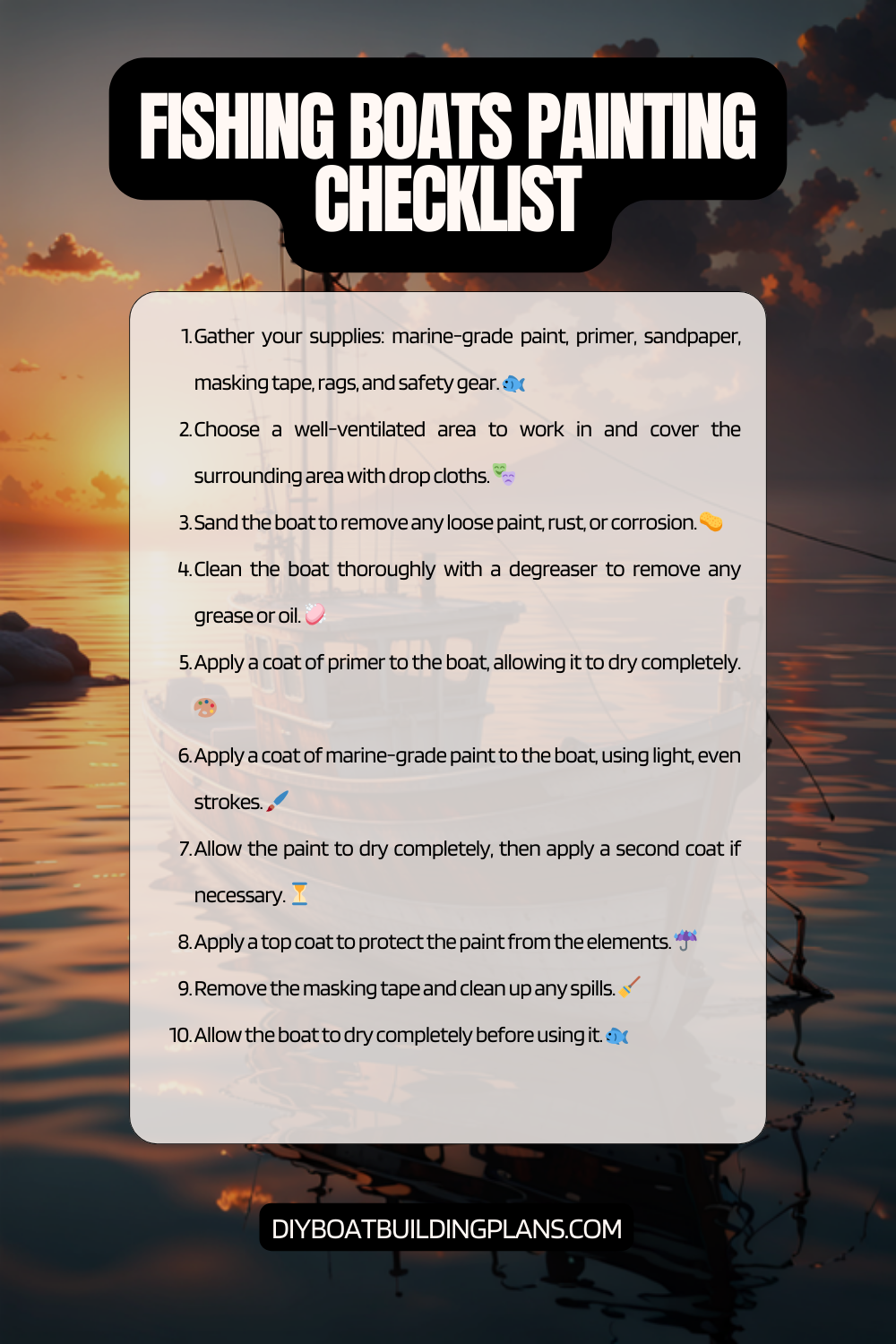Overview of Fishing Boat Painting Tips
Maintaining a good paint job on your fishing boat is crucial for several reasons. Firstly, a well-painted boat not only enhances its appearance but also protects it from the harsh elements of the water. The paint acts as a barrier against saltwater, UV rays, and other environmental factors that can cause damage to the boat’s structure. Additionally, a well-maintained paint job can increase the resale value of your fishing boat, making it an investment worth considering.
A well-painted fishing boat offers numerous benefits. Firstly, it provides protection against corrosion and rust, which can significantly extend the lifespan of your boat. Secondly, a good paint job can improve the overall performance of your boat by reducing drag and improving fuel efficiency. Lastly, a well-painted boat is aesthetically pleasing and can make your fishing trips more enjoyable.
Key Takeaways
- Choose the right paint for your fishing boat based on the material and conditions it will face.
- Proper preparation, including cleaning and sanding, is crucial for a smooth and long-lasting paint job.
- Applying primer before painting can improve adhesion and durability.
- Different techniques and tools may be needed for painting the hull, deck, and cockpit of your boat.
- Regular maintenance, including cleaning and touch-ups, can extend the life of your fishing boat’s paint job.

Choosing the Right Paint for Your Fishing Boat
When it comes to choosing the right paint for your fishing boat, there are several factors to consider. Firstly, you need to decide between using an oil-based or water-based paint. Oil-based paints are known for their durability and resistance to abrasion, making them suitable for boats that are frequently exposed to rough conditions. On the other hand, water-based paints are more environmentally friendly and easier to clean up.
Another important consideration is the type of paint finish you desire. Glossy finishes provide a high-shine look but may require more maintenance to keep them looking pristine. Satin or matte finishes offer a more subdued appearance and are often preferred for fishing boats as they tend to hide imperfections better.
When it comes to brands, there are several reputable options available in the market. Some popular brands for fishing boats include Interlux, Pettit, and Awlgrip. These brands offer a wide range of colors and finishes to choose from, ensuring that you find the perfect paint for your fishing boat.
Preparing Your Boat for Painting
Before you can start painting your fishing boat, it is essential to properly prepare the surface. This involves cleaning the boat, removing any old paint, and repairing any damages.
Start by thoroughly cleaning the boat using a mild detergent and water. Remove any dirt, grime, or grease that may be present on the surface. This step is crucial as it ensures that the paint adheres properly to the boat’s surface.
Next, remove any old paint using a paint stripper or sanding. If using a paint stripper, follow the manufacturer’s instructions carefully and ensure that you are working in a well-ventilated area. If sanding, use coarse sandpaper to remove the old paint and then switch to finer grits for a smooth finish.
Once the old paint has been removed, inspect the boat for any damages such as cracks or dents. Repair these damages using an appropriate filler or epoxy. Sand down the repaired areas to ensure a seamless finish.
Sanding Techniques for a Smooth Finish
| Technique | Description | Advantages | Disadvantages |
| Hand Sanding | Sanding by hand using sandpaper or sanding blocks. | Controlled sanding, good for small areas, inexpensive. | Time-consuming, inconsistent results, can cause fatigue. |
| Power Sanding | Sanding using power tools such as orbital sanders or belt sanders. | Efficient, consistent results, good for large areas. | Expensive, can cause damage if not used properly, noisy. |
| Wet Sanding | Sanding using water to lubricate the surface and prevent dust. | Smooth finish, reduces dust, good for finishing coats. | Time-consuming, messy, requires special equipment. |
| Buffing | Using a buffing wheel or pad to polish the surface. | High gloss finish, efficient, good for final finish. | Requires special equipment, can cause damage if not used properly. |
Sanding is a crucial step in achieving a smooth and professional-looking paint job on your fishing boat. It helps to create a clean and even surface for the paint to adhere to.
To start, gather the necessary tools for sanding, including sandpaper of various grits (ranging from coarse to fine), sanding blocks or pads, and a sanding machine if desired.
Begin by using coarse-grit sandpaper to remove any rough spots or imperfections on the boat’s surface. Sand in a circular motion, applying even pressure. As you progress, switch to finer grits of sandpaper to achieve a smoother finish.
When using a sanding machine, be cautious not to apply too much pressure as it can damage the boat’s surface. Use gentle, sweeping motions to ensure an even sanding.
After sanding, wipe down the boat with a clean cloth or tack cloth to remove any dust or debris. This step is crucial as it ensures a clean surface for the paint application.
Applying Primer to Your Fishing Boat
Applying primer is an essential step in the painting process as it helps to create a strong bond between the paint and the boat’s surface. It also provides an additional layer of protection against corrosion and improves the overall durability of the paint job.
There are different types of primers available, including epoxy primers, etching primers, and self-etching primers. The type of primer you choose will depend on the material of your fishing boat and the paint you plan to use.
Before applying the primer, ensure that the boat’s surface is clean and free from any dust or debris. Use a clean cloth or tack cloth to wipe down the surface.
Apply the primer using a brush, roller, or spray gun, following the manufacturer’s instructions. Start from one end of the boat and work your way towards the other end, applying thin and even coats. Allow each coat to dry completely before applying the next.
Once the primer has dried, lightly sand the surface with fine-grit sandpaper to create a smooth finish. Wipe down the boat again to remove any dust before proceeding with the paint application.
Tips for Painting the Hull of Your Boat
Painting the hull of your fishing boat requires careful attention to detail and proper technique to achieve a smooth and professional finish.
Start by selecting a high-quality marine-grade paint that is specifically designed for hulls. These paints are formulated to withstand constant exposure to water and provide excellent protection against corrosion.
When it comes to painting techniques, it is recommended to use a brush or roller for smaller boats and a spray gun for larger boats. Brushes and rollers allow for better control and precision, while spray guns provide a more even and efficient application.
When applying the paint, start from one end of the boat and work your way towards the other end, applying thin and even coats. Avoid applying too much paint at once, as it can lead to drips and uneven coverage. Allow each coat to dry completely before applying the next.
To achieve a smooth finish, lightly sand the surface between coats using fine-grit sandpaper. This helps to remove any imperfections and create a clean surface for the next coat of paint.
Painting the Deck and Cockpit of Your Fishing Boat
Painting the deck and cockpit of your fishing boat requires a slightly different approach compared to painting the hull. These areas are often subjected to heavy foot traffic and require a more durable paint that can withstand wear and tear.
When selecting paint for the deck and cockpit, consider using a non-skid or anti-slip paint. These paints provide better traction and reduce the risk of slipping, especially when the surface is wet.
Similar to painting the hull, start by cleaning the surface thoroughly and removing any old paint or coatings. Repair any damages using an appropriate filler or epoxy, and sand down the repaired areas for a smooth finish.
Apply the paint using a brush, roller, or spray gun, depending on your preference. Start from one end of the boat and work your way towards the other end, applying thin and even coats. Allow each coat to dry completely before applying the next.
To achieve a non-skid surface, consider adding a non-skid additive to the paint. This will create texture and improve traction on the deck and cockpit areas.
Painting Tips for Wooden Fishing Boats
Painting wooden fishing boats requires special considerations due to the unique characteristics of wood as a material.
When painting wooden boats, it is crucial to choose a paint that is specifically formulated for wood surfaces. These paints are designed to penetrate the wood fibers and provide excellent adhesion and protection against moisture.
Before painting, ensure that the wood is properly prepared. This involves cleaning the surface, removing any old paint or varnish, and sanding down the wood to create a smooth and even surface.
Apply a wood primer to the surface before painting. This helps to seal the wood and prevent any moisture from penetrating the paint layers. Follow the manufacturer’s instructions for application and drying times.
When applying the paint, use a brush or roller for better control and precision. Apply thin and even coats, allowing each coat to dry completely before applying the next. Sand between coats to achieve a smooth finish.
Painting Tips for Fiberglass Fishing Boats
Fiberglass fishing boats require specific painting techniques to ensure a long-lasting and professional finish.
Before painting fiberglass boats, it is essential to thoroughly clean the surface using a mild detergent and water. Remove any dirt, wax, or grease that may be present on the surface. Rinse thoroughly and allow the surface to dry completely.
Unlike other boat materials, fiberglass does not require a primer before painting. However, it is recommended to use a marine-grade paint that is specifically formulated for fiberglass surfaces.
When applying the paint, use a brush, roller, or spray gun depending on your preference. Start from one end of the boat and work your way towards the other end, applying thin and even coats. Allow each coat to dry completely before applying the next.
To achieve a smooth finish on fiberglass boats, it is crucial to sand between coats using fine-grit sandpaper. This helps to remove any imperfections and create a clean surface for the next coat of paint.
Download over 500 Boat Plans. Click on the link below.
-->Click Here<--
Maintaining Your Fishing Boat’s Paint Job
Once you have successfully painted your fishing boat, it is important to maintain its paint job to ensure its longevity and appearance.
Regular cleaning is essential to remove dirt, saltwater residue, and other contaminants that can damage the paint. Use a mild detergent and water solution to clean the boat’s surface, avoiding harsh chemicals that can strip away the paint.
Avoid using abrasive materials or brushes that can scratch the paint. Instead, use soft cloths or sponges to gently clean the surface.
Waxing your boat regularly can help to protect the paint and maintain its shine. Choose a marine-grade wax that is specifically formulated for boats and apply it according to the manufacturer’s instructions.
Inspect your boat regularly for any damages or signs of wear. Repair any chips, scratches, or dents promptly to prevent further damage to the paint.
The frequency of repainting your fishing boat will depend on various factors such as the type of paint used, the conditions it is exposed to, and how well it has been maintained. Generally, it is recommended to repaint your boat every 3-5 years or as needed.
Common Mistakes to Avoid When Painting Your Fishing Boat
While painting your fishing boat can be a rewarding experience, there are common mistakes that you should avoid to achieve the best results.
One common mistake is rushing through the preparation process. Properly cleaning and preparing the surface is crucial for a successful paint job. Take the time to remove old paint, repair damages, and sand the surface for a smooth finish.
Another mistake is applying too much paint at once. Thin and even coats are key to achieving a professional-looking finish. Applying too much paint can lead to drips, uneven coverage, and longer drying times.
Not allowing sufficient drying time between coats is another common mistake. Each coat of paint needs time to dry completely before applying the next. Rushing this process can result in a poor finish and compromised durability.
Lastly, neglecting regular maintenance is a mistake that can lead to premature paint failure. Regularly clean your boat, inspect for damages, and address any issues promptly to ensure the longevity of your paint job.
Fishing Boat Painting Checklist

Conclusion – Fishing Boat Painting Tips
Painting your fishing boat can be a rewarding and cost-effective way to enhance its appearance and protect it from the elements. By following the tips and techniques outlined in this article, you can achieve a professional-looking paint job that will not only make your boat stand out but also extend its lifespan.
Remember to choose the right paint for your boat, properly prepare the surface, and apply thin and even coats for the best results. Regular maintenance and care will ensure that your fishing boat’s paint job remains in top condition for years to come.
So, why not give it a try? With the right tools, materials, and techniques, you can transform your fishing boat into a work of art that you can be proud of. Happy painting!
FAQs – Fishing Boat Painting Tips
What are fishing boat painting tips?
Fishing boat painting tips are techniques and guidelines that can help you paint your fishing boat effectively and efficiently.
Why is it important to paint a fishing boat?
Painting a fishing boat is important because it helps to protect the boat from the harsh marine environment, including saltwater, UV rays, and other elements that can cause damage to the boat.
What are some common types of paint used for fishing boats?
Some common types of paint used for fishing boats include marine-grade enamel, polyurethane, and epoxy paint.
What are some preparation steps before painting a fishing boat?
Some preparation steps before painting a fishing boat include cleaning the boat thoroughly, sanding the surface to remove any old paint or rough spots, and applying a primer to help the paint adhere better.
What are some tips for painting a fishing boat?
Some tips for painting a fishing boat include using a high-quality paintbrush or roller, applying the paint in thin, even coats, and allowing each coat to dry completely before applying the next one.
How long does it take to paint a fishing boat?
The time it takes to paint a fishing boat depends on the size of the boat, the type of paint used, and the weather conditions. Generally, it can take anywhere from a few days to a few weeks to complete the painting process.



